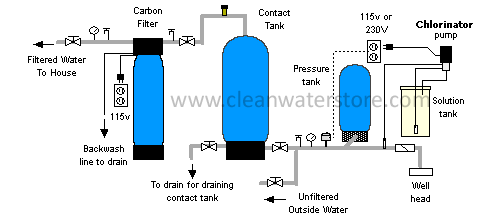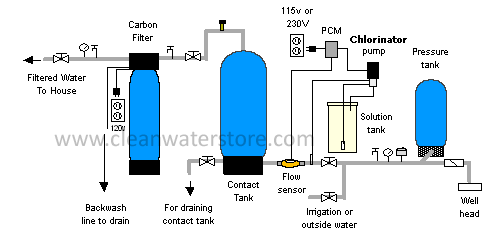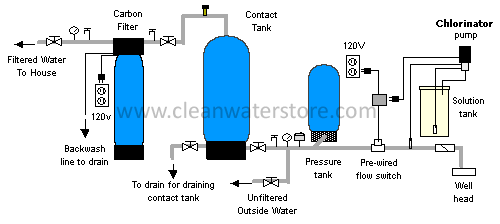Chlorine can be easily and inexpensively injected into water to kill bacteria and inactivate viruses, and/or treat water for odor, iron or manganese. The most common way to chlorinate home or small community water systems is by the use of a metering pump which pumps a small amount of liquid chlorine bleach into the water. Sufficient contact time must be allowed for the chlorine to be effective. A carbon backwash filter can be used to remove the chlorine before it enters the home if desired.
The best pump for most homeowners is the Stenner peristaltic pump which is self-priming and very easy to use and service. Liquid chlorine (bleach) is injected right out of the well, before the pressure tank. Typically a contact tank is used to allow sufficient contact or retention time for the chlorine or hydrogen peroxide to work properly.
3 methods to install a chlorinator (or hydrogen peroxide) pump for a home well system:1. Wire it so the chlorinator pump turns on when the well pump turns on.The best pump for most homeowners is the Stenner peristaltic pump which is self-priming and very easy to use and service. Liquid chlorine (bleach) is injected right out of the well, before the pressure tank. Typically a contact tank is used to allow sufficient contact or retention time for the chlorine or hydrogen peroxide to work properly.
 2. Use a proportional water meter that allows the chlorinator pump to pump more or less chlorine based on the flow rate or speed of the water. If the flow is variable, say on a gravity fed system, or if the metering pump must be after the well pump, such as on a small community system, a variable-speed proportionally-fed system must be used. These use a water meter or flow sensor to sense the speed of the water, or flow rate, and more or less chlorine is injected depending on the flow rate of the water.
2. Use a proportional water meter that allows the chlorinator pump to pump more or less chlorine based on the flow rate or speed of the water. If the flow is variable, say on a gravity fed system, or if the metering pump must be after the well pump, such as on a small community system, a variable-speed proportionally-fed system must be used. These use a water meter or flow sensor to sense the speed of the water, or flow rate, and more or less chlorine is injected depending on the flow rate of the water.
3. Use a flow switch, so that when there is flow, the metering pump turns on.

Công ty XD&TM Quang Minh
Nguyễn Quang Minh
Email:quangminhvnx@gmail.com
ĐT: 0983 265 215

Không có nhận xét nào:
Đăng nhận xét